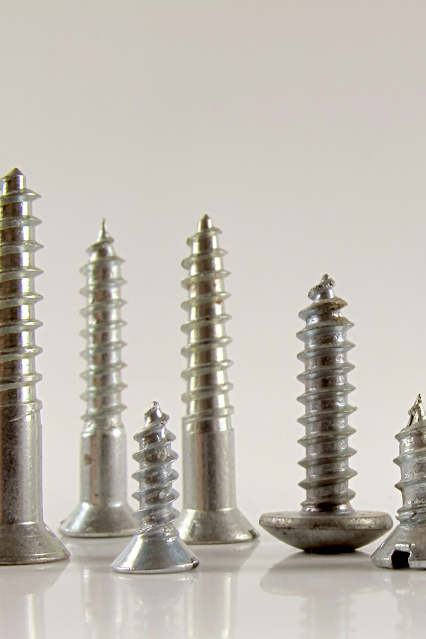If you're a DIY enthusiast, chances are that you understand the challenge of finding suitable screws to suit your project needs. Sure, everyone knows that there's more than one type of screw -- but what are those different types? Whether you're working on furniture restoration or need to buy new screws for an upcoming project at home, it pays to know the threaded truth.
Understanding the Different Types of Screws for DIY Enthusiasts
In this article, we'll take a closer look at understanding various aspects of visual identification and size measurements so DIY enthusiasts like yourself can have knowledge and confidence when it comes to selecting specific types of screws for any project.
An Overview of Different Types of Screws
Screws are minor yet essential components that bind materials together. Their shape and structure vary, depending on the purpose they are intended to be used for. One of the most commonly used types of screws by carpenters and DIY enthusiasts alike are wood screws, which feature a pointed tip for easy insertion into wood. Machine screws, on the other hand, are used for joining metal parts and typically require a nut to fasten.
Sheet metal screws are designed with a sharp, tapered end and are ideal for use in thin metals. Lag screws are longer and heavier than the rest and are used for attaching heavy materials like lumber. With a range of screws available, it is essential to select the right type for the intended task to ensure a secure and permanent fit.
Check out https://www.fastenere.com/34-wedge-anchors-zinc-plated-steel for more information on fasteners.
The Benefits of Using Phillips and Robertson Screws
When it comes to different types of screws, two terms you'll often hear are Phillips and Robertson. These refer to the shape of the screw head and corresponding screwdriver. Phillips screws have a cross-shaped indentation on their head, making them self-centering and less likely to slip during use. It makes them easier to use for DIY projects compared to flathead screws that require more precision and may easily strip or slip out of place.
Robertson screws, on the other hand, have a square-shaped indentation on their head and provide a firmer grip for the screwdriver, making them less prone to stripping or slipping. No matter what type of project you're working on, choosing between Phillips and Robertson screws comes down to personal preference and the materials being used. However, for DIY enthusiasts looking for a more efficient and reliable option, Phillips or Robertson screws are often the way to go.
How to Properly Use Slotted and Hex Screws
Slotted and hex screws are two other common types of screws that DIY enthusiasts should be familiar with. As the name suggests, slotted screws have a single slot on their head and require a flathead screwdriver for use. These screws are commonly used in furniture restoration or for small household projects. On the other hand, hex screws have a hexagonal shape on their head and require an Allen key or hex wrench for use. These are often used in machinery, bicycles, and other mechanical objects.
To ensure a secure fit when using slotted screws, it's essential to select the right screwdriver size that fits snugly into the slot without slipping or wobbling. Similarly, when using hex screws, make sure to use the correct-sized Allen key or hex wrench to avoid stripping the screw head.
Understanding the Difference Between Machine and Wood Screws
We briefly touched on the difference between machine and wood screws earlier, but it's essential to understand this distinction further. Machine screws are typically used in metal objects and require a nut to fasten. On the other hand, wood screws have coarse threading and self-tapping abilities that make them ideal for use in wood without needing a nut or pre-drilled hole.
It's crucial to use the appropriate type of screw for each material to ensure a solid and durable hold. Using machine screws in wood can cause the wood to split while using wood screws in metal will not provide a secure fit.
What You Need to Know About Self-Drilling Screws
If you're working with metal, self-drilling screws are a must-have. As the name suggests, these screws have a drill bit at the tip that allows them to penetrate through metal without the need for pre-drilled holes easily. It saves time and effort compared to using regular screws that require drilling first.
Self-drilling screws also come in different types, such as pan head, flat head, and hex head. Pan-head self-drilling screws are best for use in thicker metal sheets, while flathead screws work well with thinner metal pieces. Hex head screws provide a more secure grip and are commonly used in construction projects.
Making the Most Out of Thread-cutting Screws for DIY Projects
Thread-cutting screws, also known as self-tapping screws, are another type of screw that DIY enthusiasts should be familiar with. These screws have sharp tips and threads that allow them to tap into the material they are being used on, creating their mating threads. They are commonly used in plastic, wood, and metal materials.
When using thread-cutting screws, it's essential to choose the right size and thread type to match the material being used. Additionally, a pilot hole may be necessary when using these screws in more rigid materials to prevent them from breaking or stripping.
Related: DIY vs. Hiring a Professional: Which is the Best Choice?









Post a Comment